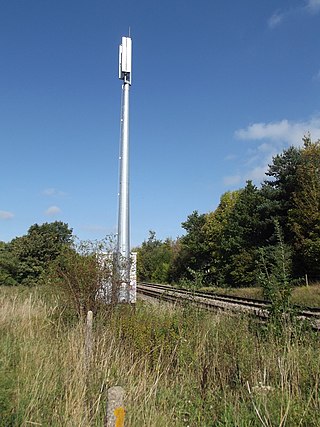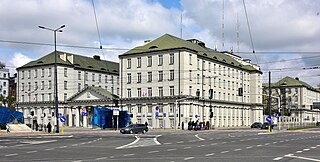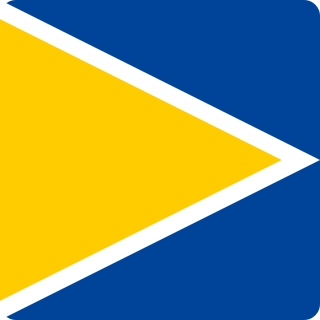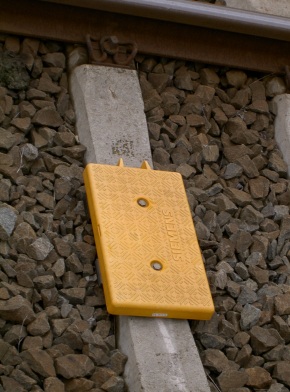Related Research Articles

The East Coast Main Line (ECML) is a 393-mile long (632 km) electrified railway between its southern terminus at London King's Cross station and Edinburgh Waverley via Peterborough, Doncaster, York, Darlington, Durham and Newcastle. The line is a key transport artery on the eastern side of Great Britain running broadly parallel to the A1 road. The main line acts as a 'spine' for several diverging branches, serving destinations such as Cambridge, Leeds, Hull, Sunderland and Lincoln, all with direct services to London. In addition, a few ECML services extend beyond Edinburgh to serve Glasgow Central, although the principal London-Glasgow route is the West Coast Main Line (WCML).

A balise is an electronic beacon or transponder placed between the rails of a railway as part of an automatic train protection (ATP) system. The French word balise is used to distinguish these beacons from other kinds of beacons.

GSM-R, Global System for Mobile Communications – Railway or GSM-Railway is an international wireless communications standard for railway communication and applications.

Automatische TreinBeïnvloeding or ATB is a Dutch train protection system first developed in the 1950s. Its installation was spurred by the Harmelen train disaster of 1962.

The Cambrian Line, sometimes split into the Cambrian Main Line and Cambrian Coast Line for its branches, is a railway line that runs from Shrewsbury, England, westwards to Aberystwyth and Pwllheli in Wales. Passenger train services are operated by Transport for Wales Rail between the western terminals of Pwllheli, in Gwynedd, and Aberystwyth, in Ceredigion, and the eastern terminal at Shrewsbury, Shropshire, as part of the Wales & Borders franchise. The railway line is widely regarded as scenic, as it passes through the Cambrian Mountains in central Wales, and along the coast of Cardigan Bay in Snowdonia National Park.

The European Train Control System (ETCS) is a train protection system designed to replace the many incompatible systems used by European railways, and railways outside of Europe. ETCS is the signalling and control component of the European Rail Traffic Management System (ERTMS).

The rail transport system in Denmark consists of 2,633 km of railway lines, of which the Copenhagen S-train network, the main line Helsingør-Copenhagen-Padborg, and the Lunderskov-Esbjerg line are electrified. Most traffic is passenger trains, although there is considerable transit goods traffic between Sweden and Germany.

Banedanmark is a Danish company that is responsible for the maintenance and traffic control on all of the state owned Danish railway network.

PKP Polskie Linie Kolejowe S.A. is the Polish railway infrastructure manager, responsible for maintenance of rail tracks, conducting the trains across the country, scheduling train timetables, and management of railway land.

Transmission Voie-Machine is a form of in-cab signalling originally deployed in France and is mainly used on high-speed railway lines. TVM-300 was the first version, followed by TVM-430.
The signalling system used on the standard-gauge railway network in Sweden is based on that of the traditional mechanical semaphore signals. Currently only colour-light signals are used, together with the Ansaldo L10000 Automatic Train Control system.
Resonate Group Limited is a British software, technology and services company. Prior to September 2016, it was called DeltaRail Group Limited.
The European Rail Traffic Management System (ERTMS) is the system of standards for management and interoperation of signalling for railways by the European Union (EU). It is conducted by the European Union Agency for Railways (ERA) and is the organisational umbrella for the separately managed parts of

A Eurobalise is a specific type of a balise installed between the rails of a railway. Eurobalises are part of the European train control system (ETCS). The balises are pre-programmed and contain information that is read by train antennas. One of their many functions is to allow a train to determine its location.

The Bologna–Florence high-speed railway is a link in the Italian high-speed rail network. It is part of Corridor 1 of the European Union's Trans-European high-speed rail network, which connects Berlin and Palermo. Full commercial operations commenced on 5 December 2009. High-speed passenger trains take 37 minutes over the route compared to about 59 minutes previously.

The Madrid–Barcelona high-speed rail line is a 621-kilometre (385.9 mi) standard gauge railway line inaugurated on 20 February 2008. Designed for speeds of 350 km/h (217.5 mph) and compatibility with neighbouring countries' rail systems, it connects the cities of Madrid and Barcelona in 2 hours 30 minutes. In Barcelona the line is connected with the Perpignan–Barcelona high-speed rail line leading into France which connects it to the European high speed network.
Transmission balise-locomotive is a train protection system used in Belgium and on Hong Kong's East Rail line.
The Chinese Train Control System is a train control system used on railway lines in People's Republic of China. CTCS is similar to the European Train Control System (ETCS).

France has a large network of high-speed rail lines. As of June 2021, the French high-speed rail network comprises 2,800 km (1,740 mi) of tracks, making it one of the largest in Europe and the world. As of early 2023, new lines are being constructed or planned. The first French high-speed railway, the LGV Sud-Est, linking the suburbs of Paris and Lyon, opened in 1981 and was at that time the only high-speed rail line in Europe.
ERTMS Regional is a simplified and low-cost variant of the European Rail Traffic Management System suitable for train control on lines with low traffic volumes. It is intended to reduce the amount of lineside and equipment required, thus reducing costs, increasing reliability and improving safety for track workers.
References
- ↑ 'ERTMS in 10 questions,' "Archived copy" (PDF). Archived from the original (PDF) on 2010-02-15. Retrieved 2016-02-27.
{{cite web}}: CS1 maint: archived copy as title (link) - ↑ "Trainguard – Full interoperability for European railways" (PDF). Braunschweig, Germany: Siemens. 2006. Retrieved 28 July 2012.[ permanent dead link ]
- ↑ Davies, David (February 2000). Automatic Train Protection for the Railway Network in Britain – A Study (PDF). Royal Academy of Engineering. pp. 73–74. ISBN 1871634881 . Retrieved 31 July 2012.
- ↑ "ERTMS Levels – Different ERTMS/ETCS Application Levels to match Customers' needs" (PDF). UNIFE – the Association of the European Rail Industry. 2012. Retrieved 22 July 2012.
- 1 2 Porter, Derek (2002). Implementing ERTMS in the UK: Human Factor Implication for Train Drivers. International Railway Safety Conference . Retrieved 24 July 2012.
It is unlikely to be financially viable to change all UK lineside signs to km/h (sic) unless the decision is taken to adopt Level 2 ERTMS without lineside signalling.
[ permanent dead link ] - ↑ "EC sets out ERTMS deployment deadlines". Railway Gazette International . 31 July 2009. Retrieved 22 July 2012.
- ↑ Ilie, Elena (22 March 2012). "ETCS, an intermodality harmonization plus". Bucharest: Railway PRO. Retrieved 28 July 2012.
- 1 2 3 "ERTMS National Implementation Plan" (PDF). Department for Transport. September 2007. Archived from the original (PDF) on 2011-07-21. Retrieved 23 July 2012.
{{cite journal}}: Cite journal requires|journal=(help) - ↑ "GE/RT8000/AM – ERTMS Rule Book – ERTMS Amendments module" (PDF) (1). Rail Safety & Standards Board. October 2009: 4, 5. Retrieved 30 July 2012.
{{cite journal}}: Cite journal requires|journal=(help)[ permanent dead link ] - ↑ "End of the line for the mile, the chain and the yard". Railnews. 1 October 2013. Retrieved 5 October 2013.
{{cite journal}}: Cite journal requires|journal=(help) - ↑ "European Rail Traffic Management System (ERTMS)". Office of Rail Regulation. 18 February 2008. Retrieved 23 July 2012.
- ↑ Silvester, Katie (August 2011). "Display mode". Rail Professional . Archived from the original on 21 April 2013. Retrieved 25 July 2012.
- ↑ "Incident at Llanbadarn Automatic Barrier Crossing (Locally Monitored), near Aberystwyth, 19 June 2011" (PDF). Accident Rail Report. Rail Accident Investigations Branch. June 2012. Figure 5 shows a 65 km/h speed restriction; Figure 10 shows a speedometer displaying 39 km/h with a 98 km/h hook. Retrieved 28 July 2012.
- ↑ "Rule Book Briefing Leaflet – ERTMS Modules" (PDF). Rail Safety & Standards Board. June 2010. Archived from the original (PDF) on June 10, 2015. Retrieved 23 July 2012.
{{cite journal}}: Cite journal requires|journal=(help) - ↑ "European Rail Traffic Management System (ERTMS)". Network Rail. Spring 2012. Retrieved 30 July 2012.
- ↑ "Delivering the plans". Network Rail. Spring 2012. Retrieved 30 July 2012.
- ↑ "Major projects update: January". Network Rail. 2020-01-30. Archived from the original on 2020-01-31. Retrieved 2020-01-31.
- 1 2 "Network Rail to pilot Digital Railway in East Anglia".
- ↑ "Norwich - Yarmouth - Lowestoft Resignalling completed". 3 April 2020.
- ↑ "Network Rail introduces new signalling on the Wherry Lines". Rail Advent. 2020-09-27.
- ↑ "Development & Implementation of ETCS". www.networkrailconsulting.com. Retrieved 2022-07-01.
- ↑ "THAMESLINK PUTTING ETCS TO WORK". www.modernrailways.com. Retrieved 2022-07-01.
- ↑ "London Thameslink ETCS signalling". rail.ricardo.com. Retrieved 2022-07-01.
- ↑ Anonymous (2019-02-14). "Crossrail Western Section Signalling". Mayor's Question Time. Retrieved 2022-07-01.
- ↑ Kessell, Clive (2020-07-02). "Crossrail's Signalling Challenge". Rail Engineer. Retrieved 2022-07-01.
- ↑ Mansfield, Ian (5 May 2022). "Signalling upgrade comes online on Great Northern line into Moorgate". www.ianvisits.co.uk. Retrieved 2022-07-01.
- ↑ "Moorgate line ETCS upgrade commissioned". www.modernrailways.com. Retrieved 2022-07-01.
- ↑ "Network Rail starts ETCS testing on Northern City Line". Railpage. Retrieved 2022-07-01.
- 1 2 "Enhancements Delivery Plan England and Wales" (PDF). September 2023.
- ↑ "ETCS goes live on Northern City line". www.modernrailways.com. Retrieved 2023-12-01.
- ↑ Burroughs, David. "East Coast Main Line ETCS installation receives £1bn funding boost". International Railway Journal. Retrieved 2022-07-01.
- ↑ "Government confirms digital go-ahead for East Coast Main Line | Railnews | Today's news for Tomorrow's railway". www.railnews.co.uk. Retrieved 2022-07-01.
- ↑ PA, Neil Lancefield; Walker, Tim (2022-06-29). "East Coast Main Line getting £1bn upgrade". YorkshireLive. Retrieved 2022-07-01.
- ↑ "East Coast Main Line (ECML), Edinburgh to London, United Kingdom". railway-technology.com (Net Resources International). 2011. Retrieved 24 July 2012.
- ↑ "ERTMS Deployment in the UK – Re-signalling as a key measure to enhance rail operations". UNIFE – the Association of the European Rail Industry). 2012. Archived from the original (PDF) on 23 March 2016. Retrieved 23 July 2012.
- ↑ "HS2 Project Specification". HS2 Ltd. January 2012. Para 4.4.
{{cite journal}}: Cite journal requires|journal=(help) - ↑ Barrow, Alan (1 December 2007). "ABA Surveying Ltd – Getting the ERTMS project off to a flying start". Venture Online – the Magazine for Business Management. Archived from the original on 5 May 2013. Retrieved 19 February 2013.
ABA have installed a system of permanent ground markers in pairs at nominal ten kilometre spacing
- ↑ "Rail Industry Standard for Onboard ETCS" (PDF). 1. Rail Safety & Standards Board. 4 September 2010. Retrieved 28 July 2012.
{{cite journal}}: Cite journal requires|journal=(help) - ↑ "Guidance on ERTMS/ETCS DMI National Requirements" (PDF). Rail Safety & Standards Board. March 2012. Para 2.1.1. Retrieved 23 July 2012.
{{cite journal}}: Cite journal requires|journal=(help)[ permanent dead link ]